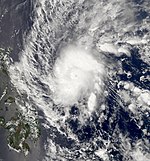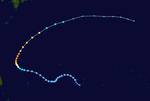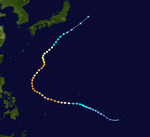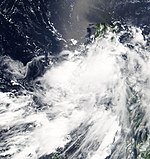2005 Pacific typhoon season
| 2005 Pacific typhoon season |

Season summary map
|
| Seasonal boundaries |
| First system formed |
January 13, 2005 |
| Last system dissipated |
December 22, 2005 |
| Strongest storm |
|
| Name |
Haitang |
| • Maximum winds |
195 km/h (120 mph) |
| • Lowest pressure |
920 hPa (mbar) |
| Seasonal statistics |
| Total depressions |
33 |
| Total storms |
24 |
| Typhoons |
13 |
| Super typhoons |
3 |
| Total fatalities |
436 |
| Total damage |
$7.64 billion (2005 USD) |
| Related articles |
|
|
Pacific typhoon seasons
2003, 2004, 2005, 2006, 2007
|
| Severe tropical storm (JMA) |
| Category 1 typhoon (SSHWS) |
|
|
| Duration |
January 13 – January 19 |
| Peak intensity |
95 km/h (60 mph) (10-min) 985 hPa (mbar) |
| Severe tropical storm (JMA) |
| Category 1 typhoon (SSHWS) |
|
|
| Duration |
March 13 – March 19 |
| Peak intensity |
100 km/h (65 mph) (10-min) 980 hPa (mbar) |
| Typhoon (JMA) |
| Category 4 typhoon (SSHWS) |
|
|
| Duration |
April 21 – April 27 |
| Peak intensity |
165 km/h (105 mph) (10-min) 935 hPa (mbar) |
| Tropical depression (JMA) |
|
|
| Duration |
May 16 – May 17 |
| Peak intensity |
<55 km/h (35 mph) (10-min) 1008 hPa (mbar) |
| Typhoon (JMA) |
| Category 4 typhoon (SSHWS) |
|
|
| Duration |
May 29 – June 11 |
| Peak intensity |
175 km/h (110 mph) (10-min) 930 hPa (mbar) |
| Tropical depression (PAGASA) |
|
|
| Duration |
July 4 – July 7 |
| Peak intensity |
55 km/h (35 mph) (10-min) 1004 hPa (mbar) |
| Typhoon (JMA) |
| Category 5 super typhoon (SSHWS) |
|
|
| Duration |
July 10 – July 21 |
| Peak intensity |
195 km/h (120 mph) (10-min) 920 hPa (mbar) |
| Tropical storm (JMA) |
| Tropical storm (SSHWS) |
|
|
| Duration |
July 18 – July 24 |
| Peak intensity |
85 km/h (50 mph) (10-min) 990 hPa (mbar) |
| Severe tropical storm (JMA) |
| Tropical storm (SSHWS) |
|
|
| Duration |
July 20 – July 27 |
| Peak intensity |
100 km/h (65 mph) (10-min) 975 hPa (mbar) |
The 2005 Pacific typhoon season was a relatively quiet season since 2000, featuring only 24 tropical storms, 13 typhoons and three super typhoons. The season ran throughout 2005, though most tropical cyclones typically develop between May and October. The season's first named storm, Kulap, developed on January 15, while the season's last named storm, Bolaven, dissipated on November 20.
Although the season was quiet, some typhoons had caused extensive damages in many places, especially in China where eight typhoons had struck the country. First, Typhoon Haitang reached peak intensity as the strongest storm within the basin this year and caused about $1 billion in damages over in Taiwan and China during mid July. In August, Typhoon Matsa made landfall over in Eastern China and caused about $2.2 billion in damages. Later that same month, two powerful typhoons were active and made landfall causing extreme damage and some casualties. Similar to Haitang, Typhoon Longwang made landfall over in Taiwan and China at a strong intensity causing damages.
The scope of this article is limited to the Pacific Ocean to the north of the equator between 100°E and 180th meridian. Within the northwestern Pacific Ocean, there are two separate agencies that assign names to tropical cyclones which can often result in a cyclone having two names. The Japan Meteorological Agency (JMA) will name a tropical cyclone should it be judged to have 10-minute sustained wind speeds of at least 65 km/h (40 mph) anywhere in the basin, whilst the Philippine Atmospheric, Geophysical and Astronomical Services Administration (PAGASA) assigns names to tropical cyclones which move into or form as a tropical depression in their area of responsibility located between 135°E and 115°E and between 5°N–25°N regardless of whether or not a tropical cyclone has already been given a name by the JMA. Tropical depressions that are monitored by the United States' Joint Typhoon Warning Center (JTWC) are given a number with a "W" suffix.
...
Wikipedia



















